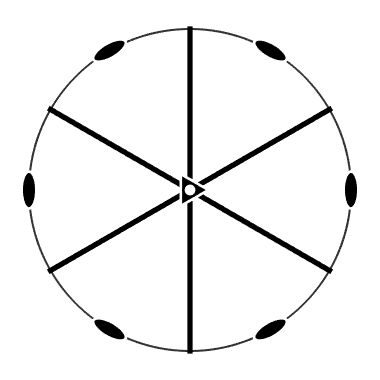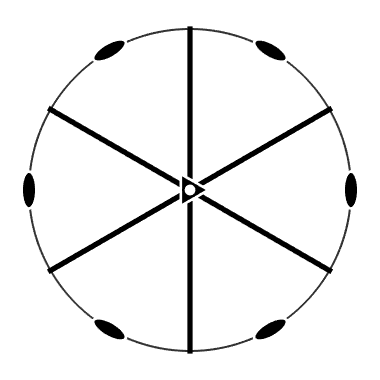Crystal and Specimen Symmetries (The Class symmetry)
This section describes the class symmetry and gives an overview how to deal with crystal symmetries in MTEX.
| On this page ... |
| Class Description |
| Defining a Crystal Symmetry |
| The Crystal Coordinate System |
| Complete Function list |
Class Description
Crystal symmetries are sets of rotations and mirroring operations that leave the lattice of a crystal invariant. They form so-called groups since the concatenation of two symmetry operations is again a symmetry operation. Crystal symmetries are classified in various ways - either according to the corresponding space group or the corresponding point group, or the corresponding Laue group. In total, there are only 11 different Laue groups present in crystallography. All these 11 Laue groups are supported by MTEX. More precisely, in MTEX a Laue group is represented by a variable of the class symmetry.
Defining a Crystal Symmetry
MTEX supports the Schoenflies notation on Laue groups as well as the international notation. In the case of noncubic crystal symmetry the length of the crystal axis has to be specified as a second argument to the constructor symmtry and in the case of triclinic crystal symmetry the angles between the axes has to be passed as the third argument. Hence, valid definitions are:
Laue Group - international notation
cs = crystalSymmetry('m-3m')cs = crystalSymmetry symmetry: m-3m a, b, c : 1, 1, 1
Laue Group - Schoenflies notation
cs = crystalSymmetry('O')cs = crystalSymmetry symmetry: 432 a, b, c : 1, 1, 1
Point Group or its Space Group
If not the name of a Laue group was specified but the name of a point group or a space group MTEX automatically determines the corresponding Laue group and assigns it to the variable.
cs = crystalSymmetry('Td')cs = crystalSymmetry symmetry: -43m a, b, c : 1, 1, 1
CIF Files
Finally, MTEX allows defining a crystal symmetry by importing a crystallographic information file (*.cif).
cs = loadCIF('quartz')cs = crystalSymmetry mineral : Quartz symmetry : 321 a, b, c : 4.9, 4.9, 5.4 reference frame: X||a*, Y||b, Z||c*
The Crystal Coordinate System
In the case of cubic crystal symmetry the crystal coordinate system is already well defined. However, especially in the case of low order crystal symmetry, the crystal coordinate system has to be specified by the length of the axis and the angle between the axis.
cs = crystalSymmetry('triclinic',[1,2.2,3.1],[80*degree,85*degree,95*degree]);A and B Configurations
In the case of trigonal and hexagonal crystal symmetries different conventions are used. One distinguishes between the A and the B configuration depending whether the a-axis is aligned parallel to the x-axis or parallel to the y-axis. In order to specify the concrete
cs = crystalSymmetry('-3m',[1.7,1.7,1.4],'X||a'); plot(cs)

cs = crystalSymmetry('-3m',[1.7,1.7,1.4],'Y||a'); plot(cs)

Complete Function list
| DocHelp 0.1 beta |